The electric milkshake machine market is estimated to be valued at USD 1962.1 million in 2025 and is projected to reach USD 3383.4 million by 2035, registering a compound annual growth rate (CAGR) of 5.6% over the forecast period. The market demonstrates robust expansion driven by foodservice industry growth, dessert consumption trends, and beverage program diversification that require specialized equipment capable of producing consistent milkshake textures while accommodating high-volume operations and diverse ingredient combinations throughout commercial food establishments.
Restaurant operators implement commercial milkshake machines that blend ice cream, milk, and flavorings into smooth beverages while maintaining temperature control and portion consistency necessary for customer satisfaction and operational efficiency. The technology's evolution toward multifunctional blending capabilities creates demand for machines that accommodate frozen yogurt, protein shakes, and specialty beverages within unified equipment platforms that maximize kitchen utility and revenue potential.
Quick-service restaurants represent the dominant consumption segment where high-capacity milkshake machines enable rapid beverage preparation during peak service periods while maintaining consistent texture and presentation standards across multiple locations and franchise operations. Kitchen managers specify equipment that accommodates varying ice cream densities and ingredient viscosities while providing easy cleaning procedures and reliable operation throughout intensive daily usage cycles.
Quality assurance protocols emphasize motor durability, temperature consistency, and food safety compliance that ensure reliable beverage preparation while meeting health department requirements and brand consistency standards throughout commercial foodservice applications.
Ice cream parlors and dessert shops demonstrate increasing adoption of specialized milkshake equipment that supports premium beverage programs and customization options including multiple flavor combinations, mix-in ingredients, and presentation styles that differentiate establishments in competitive dessert markets.
Dessert shop operators utilize machines that accommodate artisanal ice cream varieties and specialty ingredients while providing precise blending control that maintains product quality and visual appeal. Seasonal menu applications require equipment flexibility that supports limited-time offerings and promotional beverages while maintaining operational efficiency throughout varying demand patterns.
Convenience store and retail markets create specialized segments requiring compact milkshake machines that enable self-service or quick preparation capabilities while maintaining food safety standards and equipment reliability throughout extended operating hours and minimal supervision conditions.
Retail operators specify automated or semi-automated systems that reduce labor requirements while providing consistent beverage quality and portion control necessary for profitability and customer satisfaction. Frozen beverage programs utilize machines that accommodate multiple beverage types while maintaining equipment simplicity and maintenance accessibility.
Technology advancement trajectories concentrate on energy efficiency improvements and noise reduction features that optimize operational costs while maintaining equipment performance throughout continuous commercial operation. Variable speed controls enable precise blending optimization based on ingredient characteristics and desired texture while reducing energy consumption and ingredient waste. Advanced motor designs provide consistent torque and temperature management while extending equipment life and reducing maintenance requirements throughout demanding commercial environments.
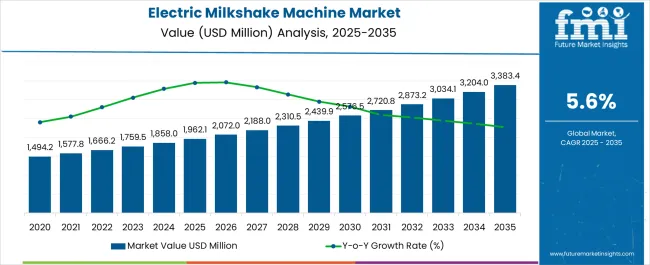
| Metric | Value |
|---|---|
| Electric Milkshake Machine Market Estimated Value in (2025 E) | USD 1962.1 million |
| Electric Milkshake Machine Market Forecast Value in (2035 F) | USD 3383.4 million |
| Forecast CAGR (2025 to 2035) | 5.6% |
The electric milkshake machine market is expanding steadily due to rising demand for quick service beverages, increasing penetration of cafes and quick service restaurants, and consumer preference for customizable drink options. Growth in urbanization and changing lifestyles have accelerated consumption of on the go beverages, driving establishments to adopt efficient and durable milkshake machines.
Technological improvements in motor efficiency, energy conservation, and multipurpose blending capabilities have enhanced operational value. Additionally, the trend toward premium beverages and the integration of milkshakes in both fast food and specialty menus is supporting equipment adoption.
The market outlook remains favorable as manufacturers continue to focus on compact designs, improved durability, and innovations that align with the growing trend of automation and consistency in food service delivery.
The market is segmented by Product Type, End User, Type, Operating Mode, and Material and region. By Product Type, the market is divided into Mixers and Mix-in Blenders. In terms of End User, the market is classified into Hotel and Restaurants, Bakery, Household, Cloud Kitchens, and Cafes. Based on Type, the market is segmented into Single Spindle, Double Spindle, and Triple Spindle. By Operating Mode, the market is divided into Manual, Semi-automated, and Fully-automated. By Material, the market is segmented into Stainless steel and Polycarbonate. Regionally, the market is classified into North America, Latin America, Western Europe, Eastern Europe, Balkan & Baltic Countries, Russia & Belarus, Central Asia, East Asia, South Asia & Pacific, and the Middle East & Africa.
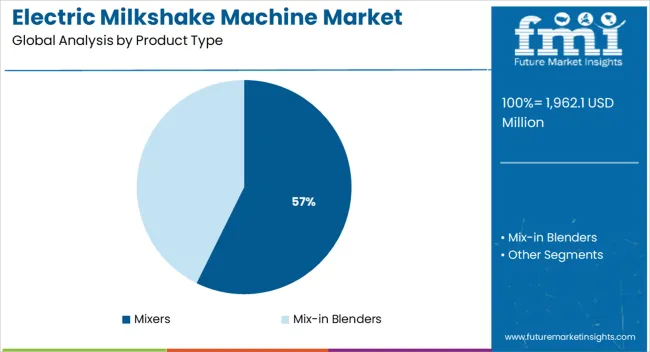
The mixers segment is anticipated to contribute 57.30% of overall revenue by 2025 within the product type category, making it the leading segment. Its dominance is attributed to the versatility of mixers in handling multiple beverage preparations, cost effectiveness, and efficiency in commercial environments.
Mixers have been widely adopted in fast paced service models where speed and consistency are crucial.
Their durability and ease of maintenance have also added to their appeal, supporting continued growth in adoption across large and small establishments alike.
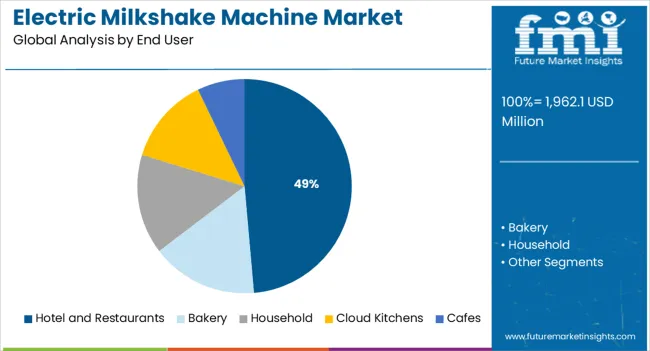
The hotel and restaurants segment is projected to hold 48.60% of total revenue within the end user category by 2025, positioning it as the dominant segment. This growth is being supported by the increasing popularity of dine out culture, rapid expansion of quick service restaurants, and rising demand for premium milkshake varieties on menus.
Hotels and restaurants are investing in electric milkshake machines to enhance beverage variety, reduce preparation time, and maintain consistent quality standards.
These factors have reinforced the segment’s leadership within the market.
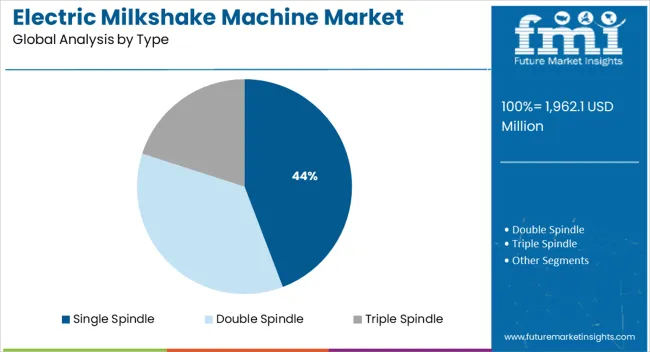
The single spindle segment is expected to account for 44.20% of market revenue by 2025 under the type category, making it the leading design. Single spindle machines are favored for their compact design, ease of installation, and cost efficiency, making them suitable for both small scale outlets and larger establishments seeking operational simplicity.
Their ability to cater to moderate volumes without compromising on performance has strengthened their adoption.
Additionally, the flexibility and ease of cleaning associated with single spindle machines have supported their continued preference, ensuring their position as the leading type segment in the market.
The worldwide sales of electric milkshake machines increased at a moderate CAGR over the past half-decade (2020 to 2024). However, for the forecast period (2025 to 2035), a steady CAGR of 5.6% has been predicted by Future Market Insights for the global electric milkshake machine industry.
Growing consumption of milkshakes along with increasing usage of electric milkshake machines across residential and commercial sectors for preparing various blended beverages is a key factor driving the global market forward.
Milkshake demand is increasing in the food service industry as a result of changing consumer preferences toward healthier and more nutritious food options. Milkshakes are becoming increasingly popular as a dessert or snack option, particularly among young people.
The proliferation of fast-food chains and restaurants that include milkshake variations on their menus is expected to play a crucial role in fostering growth in the global electric milkshake machine industry during the forecast period.
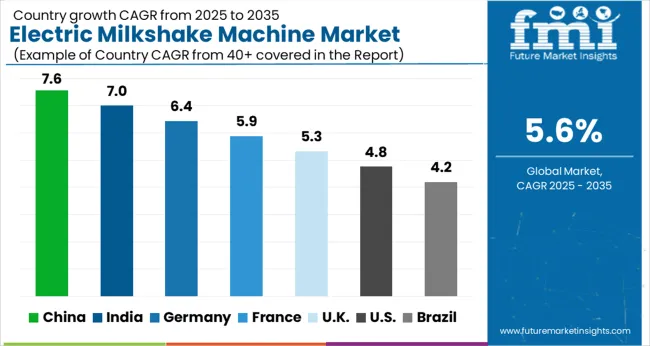
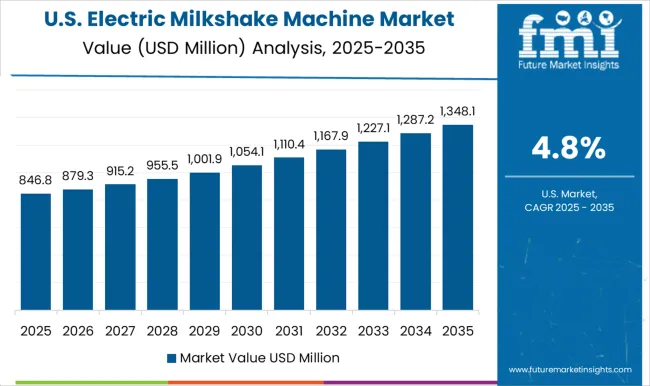
Growing Adoption across Households Fueling Sales Across United States
According to Future Market Insights, the United States electric milkshake machines market totaled a valuation of USD 1962.1 million in 2025 and it is expected to retain its dominance over the global market during the forecast period.
Increasing health-conscious consumers, hectic life schedules, and growing popularity of packaged milkshakes on account of their probiotic effect are a few factors driving demand for electric milkshake machines across the United States.
Similarly, rising adoption across residential homes along with increasing presence of restaurants and cafes is expected to propel electric milkshake machine demand in the country during the assessment period.
Rising Export of Electric Appliances Boosting Market in China
As per FMI’s latest analysis, the Asia Pacific, spearheaded by China and India, is set to emerge as the most lucrative market for electric milkshake machines market during the projection period. This is attributed to robust growth of home appliances industry, rapid urbanization, shifting consumer preferences toward western foods & beverages, and presence of leading electric milkshake machine manufacturers.
The Asia Pacific has become the hub of electronics due to presence of the world’s leading players including Philips N V, TOSHIBA Cooperation, Hitachi ltd, Apple Inc, Samsung Electronics, and Ali Groups. These companies are continuously introducing novel electrical appliances to meet end user demand.
Countries such as China and India have become leading exporters of mixers, blenders, and electric milkshake machines. China’s electrical products are gaining enormous popularity globally due to lower costs. Hence, increasing export of electric appliances is expected to create lucrative opportunities for electric milkshake machines throughout the forecast period
Increasing penetration of online shopping platforms, supermarkets, and industrial distributors across the Asia Pacific coupled with growing consumer preference towards purchasing home appliances through online mode will further boost electric milkshake sales during the assessment period.
Most of the Electric Milkshake Machine Demand to Arise from Households
Based on end user, the global electric milkshake machine industry is segmented into hotels and restaurants, bakery, cafes, cloud kitchens, and households. Among these, the household category is perhaps one of the most dominant segments, holding a prominent market share of the global market. This is attributed to the rising adoption of electric milkshake machines across households for making milkshakes, frappes, and other blended beverages.
The demand for electrical goods increases together with the world population. As households' average monthly income has increased, they are now able to buy things other than those necessary for survival.
Families have started purchasing electrical appliances such as rice cookers, blenders, and electric milkshake machines to make their life easy and comfortable. This is providing a strong thrust to the global electric milkshake machine industry and the trend is expected to continue during the forecast period.
Subsequently, factors such as rapid urbanization, changing lifestyles and eating habits, and growing trend of ‘do it yourself’ are expected to elevate electric milkshake machine demand over the projection period.
Growing Need for Saving Time and Effort Encouraging Adoption of Full-automated Machines
By operating mode, the global market is categorized into manual, semi-automated, and fully-automated. Among these, semi-automated segment holds a significant share of the electric milkshake machine industry while the fully-automated segment is expected to surge at a healthy pace during the next ten years.
As people are becoming busier than ever before, they are showing a keen inclination towards employing automatic machines for performing various tasks. Adoption of fully automatic appliances helps them to save time and effort. This is a key factor triggering sales of fully-automated electric milkshake machines globally.
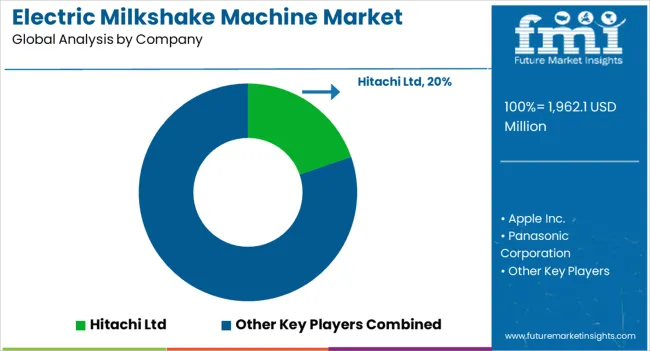
The electric milkshake machine market is led by major appliance and foodservice equipment manufacturers offering high-performance blending systems for commercial and household use. Hamilton Beach Brands Holding Co. dominates with durable, high-speed milkshake mixers designed for restaurants, cafes, and ice cream parlors, combining ease of operation with consistent blending performance. KitchenAid caters to the home appliance segment with stylish, multi-speed electric mixers that serve both casual consumers and small-scale food operators.
Vita-Mix Corp. holds a strong position in the premium segment, delivering powerful blenders suitable for professional kitchens that require smooth, high-volume milkshake and beverage preparation. Ali Group Srl and its foodservice brands provide industrial-grade milkshake machines built for durability, hygiene, and continuous operation in large commercial establishments. Electro Freeze specializes in frozen beverage and milkshake equipment, offering integrated systems used in quick-service restaurant chains. Panasonic Corporation and Hitachi Ltd. focus on versatile electric mixers and small kitchen appliances for household and semi-commercial use, emphasizing energy efficiency and compact designs.
| Attribute | Details |
|---|---|
| Market Size (2025) | USD 1962.1 million |
| Projected Market Size (2035) | USD 3383.4 million |
| Anticipated Growth Rate (2025 to 2035) | 5.6% CAGR |
| Forecast Period | 2025 to 2035 |
| Historical Data Available for | 2020 to 2024 |
| Market Analysis | USD million for Value and Units for Volume |
| Key Regions Covered | North America; Latin America; Europe; Asia Pacific; South America |
| Key Countries Covered | United States, Canada, Mexico, Germany, United Kingdom, France, Italy, Spain, China, Japan, India, South Korea, Australia, Brazil, South Africa, UAE |
| Key Segments Covered | Product Type, Operating Mode, End User, Material, Type, Region |
| Key Companies Profiled | Hitachi Ltd.; Panasonic Corporation; Ali Group Srl; Hamilton Beach Brands Holding Co.; Vita-Mix Corp.; Electro Freeze; KitchenAid. |
| Report Coverage | Market Forecast, Company Share Analysis, Competitive Landscape, DROT Analysis, Market Dynamics and Challenges, and Strategic Growth Initiatives |
The global electric milkshake machine market is estimated to be valued at USD 1,962.1 million in 2025.
The market size for the electric milkshake machine market is projected to reach USD 3,383.4 million by 2035.
The electric milkshake machine market is expected to grow at a 5.6% CAGR between 2025 and 2035.
The key product types in electric milkshake machine market are mixers and mix-in blenders.
In terms of end user, hotel and restaurants segment to command 48.6% share in the electric milkshake machine market in 2025.






Our Research Products

The "Full Research Suite" delivers actionable market intel, deep dives on markets or technologies, so clients act faster, cut risk, and unlock growth.

The Leaderboard benchmarks and ranks top vendors, classifying them as Established Leaders, Leading Challengers, or Disruptors & Challengers.

Locates where complements amplify value and substitutes erode it, forecasting net impact by horizon

We deliver granular, decision-grade intel: market sizing, 5-year forecasts, pricing, adoption, usage, revenue, and operational KPIs—plus competitor tracking, regulation, and value chains—across 60 countries broadly.

Spot the shifts before they hit your P&L. We track inflection points, adoption curves, pricing moves, and ecosystem plays to show where demand is heading, why it is changing, and what to do next across high-growth markets and disruptive tech

Real-time reads of user behavior. We track shifting priorities, perceptions of today’s and next-gen services, and provider experience, then pace how fast tech moves from trial to adoption, blending buyer, consumer, and channel inputs with social signals (#WhySwitch, #UX).

Partner with our analyst team to build a custom report designed around your business priorities. From analysing market trends to assessing competitors or crafting bespoke datasets, we tailor insights to your needs.
Supplier Intelligence
Discovery & Profiling
Capacity & Footprint
Performance & Risk
Compliance & Governance
Commercial Readiness
Who Supplies Whom
Scorecards & Shortlists
Playbooks & Docs
Category Intelligence
Definition & Scope
Demand & Use Cases
Cost Drivers
Market Structure
Supply Chain Map
Trade & Policy
Operating Norms
Deliverables
Buyer Intelligence
Account Basics
Spend & Scope
Procurement Model
Vendor Requirements
Terms & Policies
Entry Strategy
Pain Points & Triggers
Outputs
Pricing Analysis
Benchmarks
Trends
Should-Cost
Indexation
Landed Cost
Commercial Terms
Deliverables
Brand Analysis
Positioning & Value Prop
Share & Presence
Customer Evidence
Go-to-Market
Digital & Reputation
Compliance & Trust
KPIs & Gaps
Outputs
Full Research Suite comprises of:
Market outlook & trends analysis
Interviews & case studies
Strategic recommendations
Vendor profiles & capabilities analysis
5-year forecasts
8 regions and 60+ country-level data splits
Market segment data splits
12 months of continuous data updates
DELIVERED AS:
PDF EXCEL ONLINE
Electric Aircraft Onboard Sensors Market Size and Share Forecast Outlook 2025 to 2035
Electrical Label Market Size and Share Forecast Outlook 2025 to 2035
Electric Round Sprinklers Market Size and Share Forecast Outlook 2025 to 2035
Electric Cloth Cutting Scissors Market Size and Share Forecast Outlook 2025 to 2035
Electrical Insulation Materials Market Size and Share Forecast Outlook 2025 to 2035
Electric Aircraft Sensors Market Size and Share Forecast Outlook 2025 to 2035
Electric Traction Motor Market Forecast Outlook 2025 to 2035
Electric Vehicle Sensor Market Forecast and Outlook 2025 to 2035
Electric Vehicle Motor Market Forecast and Outlook 2025 to 2035
Electric Off-Road ATVs & UTVs Market Size and Share Forecast Outlook 2025 to 2035
Electric Blind Rivet Gun Market Size and Share Forecast Outlook 2025 to 2035
Electric Fireplace Market Size and Share Forecast Outlook 2025 to 2035
Electric Glider Market Size and Share Forecast Outlook 2025 to 2035
Electric Vehicle Battery Conditioners Market Size and Share Forecast Outlook 2025 to 2035
Electric Power Steering Motors Market Size and Share Forecast Outlook 2025 to 2035
Electric Motor Market Size and Share Forecast Outlook 2025 to 2035
Electric Gripper Market Size and Share Forecast Outlook 2025 to 2035
Electric Boat Market Size and Share Forecast Outlook 2025 to 2035
Electric Bicycle Market Size and Share Forecast Outlook 2025 to 2035
Electric Vehicle Transmission Market Size and Share Forecast Outlook 2025 to 2035

Thank you!
You will receive an email from our Business Development Manager. Please be sure to check your SPAM/JUNK folder too.
Chat With
MaRIA